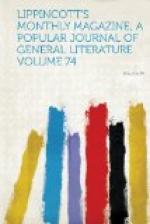The very form and traits of Woe.
I drained the galled dregs of the draught
She offered me: I could have laughed
In irony of sheer despair,
Although I could not weep. The air
Thickened with twilight shadows dim:
I rose and left. I knew each limb
Of these great trees, each gnarled, rough root
Piercing the clay, each cone of fruit
They bear in autumn.
What blooms here,
Filling the honeyed atmosphere
With faint, delicious fragrancies,
Freighted with blessed memories?
The earliest March violet,
Dear as the image of Regret,
And beautiful as Hope. Again
Past visions thrill and haunt my brain.
Through tears I see the nodding head,
The purple and the green dispread.
Here, where I nursed despair that morn,
The promise of fresh joy is born,
Arrayed in sober colors still,
But piercing the gray mould to fill
With vague sweet influence the air,
To lift the heart’s dead weight of care,
Longings and golden dreams to bring
With joyous phantasies of spring.
EMMA LAZARUS.
WHAT IS A CONCLAVE?
It may be that before these lines meet the eye of the readers they are intended for the world will be once again witnessing that function of the Roman Catholic Church which of all others makes the highest pretensions to transcendental spiritual significance, and is in reality the most utterly and grossly mundane—a conclave. In any case, it cannot be long before that singular spectacle is enacted on the accustomed stage before the converging eyes of Christendom. In any case, too, it will be nearly thirty years since the world has seen the like. And never before since St. Peter sat (or did not sit) in the seat of the Roman bishops has so long a period elapsed unmarked by the election of a supreme pontiff. The coming conclave will be held under circumstances essentially dissimilar from those surrounding all its predecessors, as will be readily understood if we consider the difference which recent changes, both lay and ecclesiastical, have made in the position of the pope. If, on the one hand, the political changes in Europe have taken from the cardinals the power of creating a sovereign prince, the ecclesiastical changes which the late ecumenical council has wrought in the constitution of the Church have placed in their hands the power and duty of selecting a supreme ruler of the Church with acknowledged claims to a loftier and more tremendous authority than the most high-handed of his predecessors has hitherto claimed. And the nature of this authority is such that the political rulers of the world may well feel—and are, as we know, feeling—a more anxious interest in the result of the election than they have for many a generation felt in the elevation of a temporal ruler of the ci-devant States of the Church. Under these circumstances it may be acceptable to our readers to have some brief account of what conclaves are and have been.




